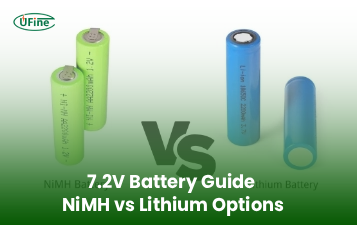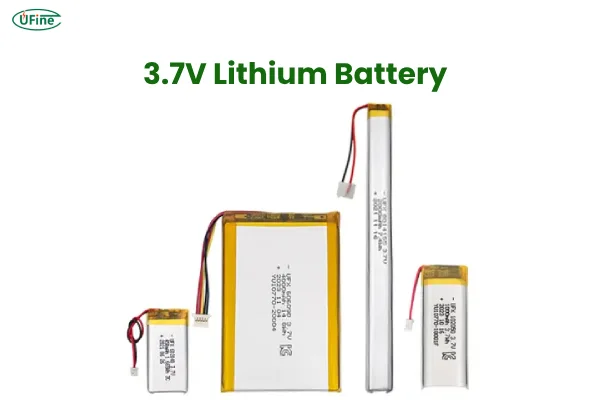
- Part 1. Understanding 1.5V lithium-ion batteries
- Part 2. Understanding 3.7V lithium batteries
- Part 3. Key differences between 1.5V and 3.7V lithium batteries
- Part 4. Use cases: which battery is right for your application?
- Part 5. Advantages and disadvantages
- Part 6. Safety, cost, and lifespan comparison
- Part 7. Can 1.5V lithium-ion battery and 3.7V lithium battery be interchangeable?
- Part 8. How to choose the right battery for your device
- Part 10. Why choose custom lithium batteries from Ufine Battery?
- Part 11. Final thoughts
Batteries power nearly every modern device we rely on daily—from flashlights and toys to smartphones and medical equipment. Among the many types available, 1.5V lithium-ion batteries and 3.7V lithium batteries are two commonly used power sources. But which one is better? More importantly, which one suits your specific application?
This article compares both battery types, diving deep into their voltage characteristics, chemistry, form factor, applications, and safety. If you’re trying to decide between these two, or simply want to understand the difference, this guide is for you.
Part 1. Understanding 1.5V lithium-ion batteries

A 1.5V lithium-ion battery is designed to replicate the standard voltage of traditional alkaline AA and AAA batteries, which are commonly used in low-voltage household devices. However, unlike standard disposable alkaline cells, these lithium-ion versions are rechargeable and often include built-in circuitry to regulate voltage.
Key Features:
- Nominal voltage: 1.5V (regulated output)
- Chemistry: Lithium-ion core with internal voltage regulation
- Form factor: Typically AA or AAA
- Rechargeable: Yes
- Integrated Protection Circuit Module (PCM): Yes, to stabilize output voltage and ensure safety
Typical Applications:
- Remote controls
- Digital thermometers
- Wireless mice and keyboards
- Portable radios
- Low-drain consumer electronics
These batteries provide the convenience of traditional 1.5V batteries while offering the benefits of lithium-ion rechargeability.
Part 2. Understanding 3.7V lithium batteries
3.7V lithium batteries, on the other hand, are the standard in consumer electronics and rechargeable devices. They are often built using Lithium Polymer (LiPo) or Lithium-Ion (Li-ion) chemistry and are used in high-performance devices that require stable, high-energy output.
Key Features:
- Nominal voltage: 3.6V–3.7V (actual range 3.0V–4.2V during discharge/charge)
- Chemistry: Lithium-ion (Li-ion or LiPo)
- Available in many shapes and sizes (cylindrical, pouch, prismatic)
- Rechargeable: Yes
- No voltage regulation unless added externally
Typical Applications:
- Smartphones
- Drones
- Bluetooth speakers
- Wearable devices
- Medical devices
These batteries are known for their high energy density and are essential for modern rechargeable electronics.
Part 3. Key differences between 1.5V and 3.7V lithium batteries
Feature1.5V Lithium-Ion Battery3.7V Lithium BatteryNominal Voltage1.5V (regulated)3.6–3.7VVoltage RangeInternally regulated3.0V–4.2VChemistryLithium-ion with step-down circuitryLithium-ion or LiPoForm FactorAA/AAA cylindricalCylindrical, prismatic, pouchApplicationsLow-drain devicesHigh-drain electronicsRechargeabilityYesYesIntegrated PCMAlways includedOptionalEnergy DensityLowerHigher
A 1.5V lithium-ion battery mimics disposable batteries with the added benefit of being rechargeable. In contrast, 3.7V lithium batteries are power-dense, designed for advanced electronic devices that need more energy and flexibility.
Part 4. Use cases: which battery is right for your application?
Choose 1.5V Lithium-Ion Battery If:
- Your device originally uses AA or AAA batteries
- You need stable voltage from start to end of discharge
- You want to upgrade from alkaline batteries to rechargeable ones without changing the device
Choose 3.7V Lithium Battery If:
- You’re powering a smartphone, drone, or wearable
- You’re designing a custom electronic product
- Your device has charging electronics built-in
- You require high energy output and longer runtime
For example, a remote control or blood pressure monitor would benefit more from a 1.5V lithium-ion battery, while a drone or portable scanner would work best with a 3.7V lithium battery.
Part 5. Advantages and disadvantages
1.5V Lithium-Ion Battery:
Pros:
- Rechargeable replacement for disposable AA/AAA
- Stable voltage output
- Safe to use in legacy devices
- Environmentally friendly
Cons:
- Lower energy capacity than 3.7V cells
- Limited use to devices designed for 1.5V
3.7V Lithium Battery:
Pros:
- High energy density
- Compact form factor
- Suitable for demanding electronics
- Widely used in modern applications
Cons:
- Requires dedicated charging circuit
- Voltage drops over time (if not regulated externally)
Choosing between them depends on the balance between performance and compatibility.
Part 6. Safety, cost, and lifespan comparison
Safety:
- 1.5V batteries are often safer due to built-in PCM and lower voltage operation.
- 3.7V batteries must be carefully managed to avoid overcharging, overheating, or short circuits.
Cost:
- 1.5V lithium-ion batteries are generally more expensive per unit but replace dozens of disposable alkaline batteries over time.
- 3.7V lithium batteries vary by size and capacity. They are more affordable in bulk for manufacturing.
Lifespan:
- 1.5V: Typically lasts 500–1000 recharge cycles.
- 3.7V: Usually 300–800 recharge cycles depending on chemistry and use.
Proper battery management can extend life regardless of type.
Part 7. Can 1.5V lithium-ion battery and 3.7V lithium battery be interchangeable?
The short answer is no, a 1.5V lithium-ion battery and a 3.7V lithium battery are not interchangeable. They differ significantly in voltage, design, output behavior, and application compatibility.
Voltage Incompatibility
The most critical factor is voltage. A device designed for a 1.5V input (such as AA battery slots) will likely be damaged or malfunction if supplied with 3.7V, which is more than double the intended voltage. Conversely, a 3.7V device won’t function properly if it only receives 1.5V—it will underperform, fail to power on, or drain faster.
Physical and Electronic Differences
- 1.5V lithium-ion batteries often come in standard AA or AAA sizes to fit common household devices. They have integrated voltage regulation circuits that step down the internal voltage to a consistent 1.5V output.
- 3.7V lithium batteries come in a wide range of shapes and sizes (like pouch or cylindrical cells) and do not have output regulation unless specifically designed with a protection or regulation board.
Device Design Matters
Even if a 3.7V battery physically fits into a 1.5V slot (which is rare), the device’s circuit is unlikely to be rated for the higher voltage. This can lead to:
- Component burnout
- Shortened device lifespan
- Safety hazards like overheating or fire
Custom Electronics May Allow Regulation
In some custom electronic applications, you can step down 3.7V to 1.5V using buck converters or regulators. However, this approach is typically used by engineers or product developers—not for plug-and-play consumer use.
In summary, these two batteries are designed for completely different applications. They should not be used as substitutes for each other unless your device has been explicitly engineered to support both through intelligent power management and voltage conversion.
If you’re unsure about which battery to use for your product or project, consider reaching out to Ufine Battery, a leading custom lithium battery manufacturer. Their team of experts can help design a battery solution tailored exactly to your voltage and power needs.
Part 8. How to choose the right battery for your device
To make the right choice between 1.5V lithium-ion battery and 3.7V lithium battery, ask the following:
What is the device’s voltage requirement?
- 1.5V: Choose a 1.5V regulated lithium-ion battery
- Higher voltage or variable load: Go for 3.7V lithium battery
Does the device already use AA/AAA batteries?
- Yes → 1.5V lithium-ion is a drop-in replacement
Do you have a custom project?
- Choose 3.7V lithium batteries from a custom battery supplier
How critical is energy density and weight?
- Choose 3.7V for high density and light weight
Part 10. Why choose custom lithium batteries from Ufine Battery?
If you’re a manufacturer, electronics developer, or systems integrator looking for reliable lithium power solutions, consider working with Ufine Battery.
Ufine Battery is a professional Chinese custom lithium battery manufacturer specializing in:
- 1.5V lithium-ion batteries
- 3.7V Li-ion and LiPo batteries
- 18650, pouch, and prismatic cell designs
- Custom battery pack solutions
- Ultra-thin, high/low-temperature, and high-rate lithium batteries
Whether you’re developing consumer electronics, medical equipment, IoT devices, or industrial tools, Ufine offers:
- Free consultation
- Customized battery design
- Certifications (UL, CE, UN38.3)
- Fast global delivery
Get in touch with Ufine Battery today to find the perfect battery for your needs.
Part 11. Final thoughts
The choice between a 1.5V lithium-ion battery and a 3.7V lithium battery ultimately depends on your specific needs. While the 1.5V version offers backward compatibility and ease of use, the 3.7V battery provides better energy density and performance.
Each type has its strengths—and selecting the right one can ensure safety, improve efficiency, and reduce long-term costs.
Related Tags:
More Articles

NiMH vs Lithium 7.2V Battery and Charger: Which Is Better?
Compare 7.2V NiMH vs Lithium batteries and chargers in 2025. Learn runtime, weight, charging, lifespan, and cost to choose the best for your device.
How to Choose the Right 7.2V Battery and Charger for Your Device?
Learn how to choose the right 7.2V battery and charger for optimal performance, safety, and longevity across RC, tools, medical, and industrial devices.
Big Square Battery Safety Standards You Must Know
Learn key safety standards for big square batteries to avoid fire risks, shipping delays, and compliance issues in EV, industrial, and energy storage projects.
Big Square Battery Applications in Solar & Industrial Equipment
Big square batteries deliver high capacity, stable output, and long life for solar, industrial, and backup power. Explore key uses and advantages.
Big Square Battery vs Cylindrical Battery: Complete 2025 Guide for EVs, ESS & Industrial Devices
Choosing the right battery is key for designers and engineers. Compare big square vs cylindrical batteries to find the best fit for your application.



